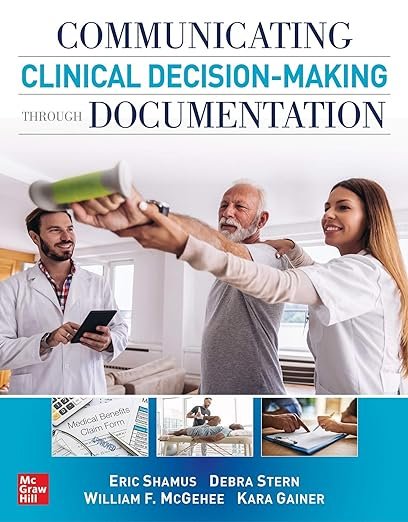Communicating Clinical Decision-Making Through Documentation: CodingPayment, and Patient Categorization 1st Edition,
In today’s complex healthcare environment, clear and accurate clinical documentation plays an integral role in coding, payment systems, and patient categorization. Communicating Clinical Decision-Making Through Documentation (1st Edition) by Eric Shamus, Debra F. Stern, and William F. McGehee provides an in-depth exploration of how effective documentation can enhance clinical decision-making while ensuring proper coding and reimbursement processes. The book focuses on the communication of clinical decisions in a structured manner that serves both healthcare providers and payers, streamlining payment systems and ensuring proper patient categorization.
Understanding the Role of Documentation in Clinical Decision-Making
This book emphasizes how clinical decision-making is communicated through medical documentation and how it affects the broader healthcare system. The authors address the need for precise and thorough documentation to ensure that clinical decisions are clearly conveyed to all stakeholders, from clinicians to insurance companies and third-party payers. Accurate documentation is not only essential for effective patient care but also crucial in determining the payment processes associated with healthcare services.
Key Topics Covered in the Book
1. Clinical Decision-Making and Documentation
The first part of the book provides a foundational overview of clinical decision-making and its relationship to medical documentation. The authors explore how clinical decisions impact the documentation process and how these decisions can be communicated in a way that ensures compliance with healthcare regulations. The section highlights how well-documented clinical judgments can optimize patient care while preventing errors in coding or reimbursement.
2. Healthcare Coding Systems
A significant portion of the book is dedicated to healthcare coding systems and how they affect payment and reimbursement. It delves into the coding guidelines and standards required for effective communication of clinical decisions within the context of medical records. Through practical examples, Communicating Clinical Decision-Making Through Documentation readers learn how to accurately assign diagnosis codes, procedure codes, and other essential identifiers that influence the payment process. The authors also cover the importance of using the appropriate coding systems like ICD-10, CPT, and HCPCS in maintaining the integrity of the reimbursement system.
3. Payment Systems and Reimbursement Models
This section discusses how documentation impacts the payment systems in healthcare, specifically focusing on the relationship between clinical decisions, documentation, and reimbursement. The authors explore the complex dynamics of healthcare payments, including third-party payer systems, Medicare, and private insurance, emphasizing the importance of coding and documentation accuracy for ensuring proper reimbursement.
4. Patient Categorization and its Impact on Healthcare Delivery
Effective patient categorization is essential for delivering appropriate care and for ensuring that reimbursement is aligned with the level of care provided. The book examines how medical documentation aids in categorizing patients based on the severity of their conditions, treatment needs, and clinical decisions. The authors discuss the importance of accurately documenting the patient’s medical history, diagnosis, and care plan, as it directly impacts the care pathway and the funding allocated for treatments.
5. Challenges and Best Practices
Throughout the book, Shamus, Stern, and McGehee offer practical advice on how to overcome challenges in clinical documentation and improve the overall documentation process. They discuss common pitfalls in coding and reimbursement and provide strategies for improving the communication of clinical decisions through better documentation practices. The book also outlines best practices for healthcare professionals in improving documentation accuracy to ensure proper reimbursement and avoid costly errors.
Who Should Read This Book?
- Healthcare Providers: Clinicians and healthcare professionals involved in patient care, including physicians, nurses, and allied health professionals, will benefit from this book as it provides insights into how clinical documentation impacts patient care and payment.
- Medical Coders and Billers: This book is an essential guide for medical coders and billers who are responsible for ensuring that clinical decisions are accurately translated into billing codes for proper reimbursement.
- Health Administrators: Healthcare administrators and policy makers will find this book valuable as Communicating Clinical Decision-Making Through Documentation it discusses the broader implications of clinical decision-making, coding, and reimbursement in the context of health system management.
- Students in Healthcare or Health Informatics: Ideal for students in fields such as healthcare management, medical coding, or health informatics, the book offers a practical introduction to the documentation and reimbursement processes.
- Compliance Officers: Those responsible for ensuring compliance with healthcare regulations will find this book helpful in understanding how accurate documentation can prevent compliance issues.
Conclusion
Communicating Clinical Decision-Making Through Documentation (1st Edition) is an indispensable resource for healthcare professionals involved in clinical decision-making, documentation, coding, payment systems, and patient categorization. Eric Shamus, Debra F. Stern, and William F. McGehee provide practical insights into how well-structured documentation can improve the accuracy of clinical decisions, enhance patient care, and ensure proper payment and reimbursement. Whether you’re a clinician, coder, healthcare administrator, or student, this book offers valuable knowledge to navigate the complexities of modern healthcare documentation.
YOU MAY LIKE .https://natashabookstore.com/books/applied-mechanics-3rd-edition/













Reviews
There are no reviews yet.